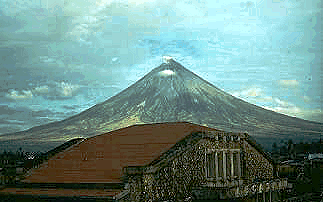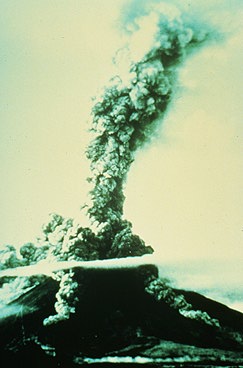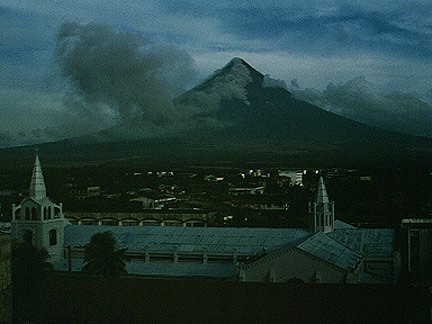|
|
| Image courtesy: USGS |
Beautifully symmetrical Mayon volcano, which rises to 2462 m above the Albay Gulf, is the Philippines' most active volcano. The structurally simple volcano has steep upper slopes averaging 35-40 degrees that are capped by a small summit crater. The historical eruptions of this basaltic-andesitic volcano date back to 1616 and range from strombolian to basaltic plinian, with cyclical activity beginning with basaltic eruptions, followed by longer term andesitic lava flows. Eruptions occur predominately from the central conduit and have also produced lava flows that travel far down the flanks. Pyroclastic flows and mudflows have commonly swept down many of the approximately 40 ravines that radiate from the summit and have often devastated populated lowland areas. Mayon's most violent eruption, in 1814, killed more than 1200 people and devastated several towns. (Description courtesy SI/USGS Global Volcanism Program)
|
Mayon volcano, in SE Luzon, is the most active volcano in the Philippines. Its classic, symmetrical profile, which rises above the Albay Gulf to a height of 2462 m, is the result of a structurally simple volcano where eruptions have occurred from a single central conduit. Mayon's frequent historical eruptions, recorded since 1616, have typically included powerful explosive activity accompanied by pyroclastic flows, mudflows, and lava flows that descended to the lower flanks of the volcano. Photo by Kurt Fredrickson, 1968 (Smithsonian Institution). |
 Photograph by Gordon Macdonald, U.S. Geological Survey, December 4, 1953. Mayon has the classic conical shape of a stratovolcano. It is the most active volcano in the Philippines. Since 1616, Mayon has erupted 47 times. |
 Nue ardentes, like the ones in the above photo, were recorded at 18 of these eruptions. Twelve eruptions have caused fatalities. Photograph by Jim Moore, U.S. Geological Survey, April, 1968. |
The most recent eruption, in 1993, began unexpectedly with an explosion.
The initial eruption lasted only 30 minutes but it generated pyroclastic flows that killed 68 people and prompted the evacuation of 60,000 others.
This photo shows pyroclastic flows descending Mayon on March 2, 1993.

Photograph credit: Steve O'Meara of Volcano Watch International.
The Legend of Magayon
Legend attempts to unravel the mystery of the origin of this magnificent chunk of earth. It seems that there once lived a very beautiful native princess who had an uncle named Magayon. He was so possessive of his niece that no man dared to challenge his wrath by courting the favors of the young maiden. One day, however, a brave and virile warrior was so smitten by the princess that he threw all cares to the wind, clambered up through the window of the royal chamber and enticed the girl to elope with him. With Magayon at their heels, the couple prayed to the gods for assistance. Suddenly from out of nowhere, a landslide buried the raging uncle alive. Local folks now claim that it is Magayon's anger bursting forth in the form of eruptions.
Sources of Information:
USGS/SI Global Volcanism Program Mayon Information
Dyott, G.M., "The Volcanoes of Ecuador, Guideposts in Crossing South America," National Geographic, pp. 49-93, January, 1929.
Simkin, Tom and Siebert, Lee, "Volcanoes of the World," Geoscience Press, Tuscon, AZ, 349 pp., 1994.
Global Volcanism Network, 1993, Summary of recent volcanic activity: Bulletin of Volcanology, v. 55, no. 4, p. 301.
McClelland, L., Simkin, T., Summers, M., Nielsen, E., and Stein, T.C., 1989, Global Volcanism 1975-1985, Prentice Hall, Englewood Cliffs, New Jersey, 655 p.
Moore, J.G., and Melson, W.G., 1969, Nuee ardentes of the 1968 eruption of Mayon volcano, Philippines: Bulletin of Volcanology, v. 33, p. 600-620.
Newhall, C.G., 1979, Temporal variations in the lavas of Mayon volcano, Philippines: Journal of Volcanology and Geothermal Research, v. 5, p. 61-84.
Simkin, T., and Siebert, L., 1994, Volcanoes of the World: Geoscience Press, Tucson, AZ, 349 p.
Philippines Department of Tourism